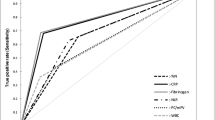Abstract
Purpose
The purpose of this study was to evaluate the diagnostic value of interleukin-6 (IL-6) and other inflammatory markers including C-reactive protein (CRP), erythrocyte sedimentation rate (ESR), and white blood cell count (WCC) in diagnosis of PJI.
Methods
The study group included 40 patients (21 males, 19 females) admitted for surgical intervention after knee or hip arthroplasties. Patients were subjected to careful history taking, thorough clinical examination and pre-operative laboratory investigations including serum IL-6, CRP, WCC and ESR. Peri-implant tissue specimens were subjected to microbiological culture and histopathological examination.
Results
The mean age of patients was 58.4 years (range, 38–72 years). Intra-operative cultures and histopathological examination revealed 11 patients had been infected (PJI) and 29 patients were aseptic failure of prosthesis. Four presumed markers of infection were tested preoperatively: ESR, CRP, WCC, and IL-6. ESR (p = 0.0001), CRP (p = 0.004), WCC (0.0001), and IL-6 (p = 0.0001) were significantly higher in patients with septic revision than those with aseptic failure of the prosthesis. Serum IL-6 (>10.4 pg/ml) reportedly had a sensitivity of 100 %, a specificity of 90.9 %, a PPV of 79 %, a NPV of 100 %, and accuracy of 92.5 %.
Conclusions
The present study demonstrated that IL-6 has been found to be the most accurate laboratory marker for diagnosing PJI when compared to ESR, CRP, and WCC. IL-6 above 10.4 pg/ml and CRP level above 18 mg/L will identify all patients with PJI and the combination of CRP + IL-6 is an excellent screening test to identify all such patients (sensitivity 100 %, NPV 100 %).
Similar content being viewed by others
References
Buttaro MA, Tanoira I, Comba F, Piccaluga F (2010) Combining C-reactive protein and interleukin-6 may be useful to detect periprosthetic hip infection. Clin Orthop Relat Res 468:3263–3267
Miyamae Y, Inaba Y, Kobayashi N, Choe H, Ike H, Momose T, Fujiwara S, Saito T (2012) Quantitative evaluation of periprosthetic infection by real-time polymerase chain reaction: a comparison with conventional methods. Diag Microbiol Inf Dis 74:125–130
Phillips JE, Crane TP, Noy M et al (2006) The incidence of deep prosthetic infections in a specialist orthopaedic hospital: a 15-year prospective survey. J Bone Joint Surg (Br) 88-B:943
Kurtz SM, Lau E, Schmier J, Ong KL, Zhao K, Parvizi J (2008) Infection burden for hip and knee arthroplasty in the United States. J Arthroplasty 23:984–991
Jamsen E, Varonen M, Huhtala H et al (2010) Incidence of prosthetic joint infections after primary knee arthroplasty. J Arthroplasty 25:87
Poultsides LA, Liaropoulos LL, Malizos KN (2010) The socioeconomic impact of musculoskeletal infections. J Bone Joint Surg Am 92-A:e13
Ong KL, Kurtz SM, Lau E et al (2009) Prosthetic joint infection risk after total hip arthroplasty in medicare population. J Arthroplasty 24(6):105
Wetters NG, Berend KR, Lombardi AV, Morris MJ, Tucker TL, Della Valle CJ (2012) Leucocyte esterase reagent strips for the rapid diagnosis of periprosthetic joint infection. J Arthroplasty 27(8):8–11
Odak S, McNicholas M (2012) Diagnosis and management of infection after total knee arthroplasty. Orthop Trauma 26(2):80–85
Wirtz DC, Heller KD, Miltner O, Zilkens KW, Wolff JM (2000) Interleukin-6: a potential inflammatory marker after total joint replacement. Int Orthop 24:194–196
Shah K, Mohammad A, Patil S, McFadyen A, Meek RMD (2009) Circulating cytokines after hip and knee arthroplasty. Clin Orthop Relat Res 467:946–951
Sood R (2009) Medical laboratory technology: methods & interpretations, vol 1, 6th edn. JAYPE, New Delhi, pp 284–287
Roberts L (2007) Specimen collection and processing. In: Mahon CR, Lehman DC, and Manuselis G (eds), Textbook of diagnostic microbiology, 4th edition. Saunders Elsevier, Ch. 6, pp 111–125
Virolainen P, Lahteenmaki H, Hiltunen A et al (2002) The reliability of diagnosis of Infection during revision arthroplasties. Scand J Surg 91(1):178
Shih LY, Wu JJ, Yang DJ (1987) Erythrocyte sedimentation rate and C-reactive protein values in patients with total hip arthroplasty. Clin Orthop Relat Res 225:238–246
Drago L, Vassena C, Dozio E, Corsi MM, De Vecchi E, Mattina R, Romanò C (2011) Procalcitonin, C-reactive protein, interleukin-6, and soluble intercellular adhesion molecule-1 as markers of postoperative orthopaedic joint prosthesis infections. Int J Immunopathol Pharmacol 24(2):433–440
Kalore NV, Gioe TJ, Singh JA (2011) Diagnosis and management of infected total knee arthroplasty. Open Orthop J 5:86–91
Windsor RE, Insall JN, Urs WK, Miller DV, Brause BD (1990) Two-stage reimplantation for the salvage of total knee arthroplasty complicated by infection: Further follow-up and refinement of indications. J Bone Joint Surg Am 72-A(2):272–278
Bottner F, Wegner A, Winkelmann W, Becker K, Erren M, Gotze C (2007) Interleukin-6, procalcitonin, TNF-α markers of peri-prosthetic infection following total joint replacement. J Bone Joint Surg (Br) 89-B:94–99
Spangehl J, Masri BA, O’Connell JX, Duncan CP (1999) Prospective analysis of preoperative and intraoperative investigations for the diagnosis of infection at the sites of two hundred and two revision total hip arthroplasties. J Bone Joint Surg Am 81-A:672–683
Bedair H, Ting N, Jacovides C et al (2011) The Mark Coventry Award: diagnosis of early postoperative TKA infection using synovial fluid analysis. Clin Orthop Relt Res 469:34–40
Sanzen L, Sundberg M (1997) periprosthetic low grade hip infection: erythrocyte sedimentation rate and C-reactive protein in 23 cases. Acta Orthop Scand 68:461–465
Dicesaro PE, Chang E, Preston CF, Liu CJ (2005) Serum interleukin-6 as a marker of peri-prosthetic infection following total hip and knee arthroplasty. J Bone Joint Surg Am 87-A:1921–1927
Author information
Authors and Affiliations
Corresponding author
Rights and permissions
About this article
Cite this article
Elgeidi, A., Elganainy, A.E., Abou Elkhier, N. et al. Interleukin-6 and other inflammatory markers in diagnosis of periprosthetic joint infection. International Orthopaedics (SICOT) 38, 2591–2595 (2014). https://doi.org/10.1007/s00264-014-2475-y
Received:
Accepted:
Published:
Issue Date:
DOI: https://doi.org/10.1007/s00264-014-2475-y




